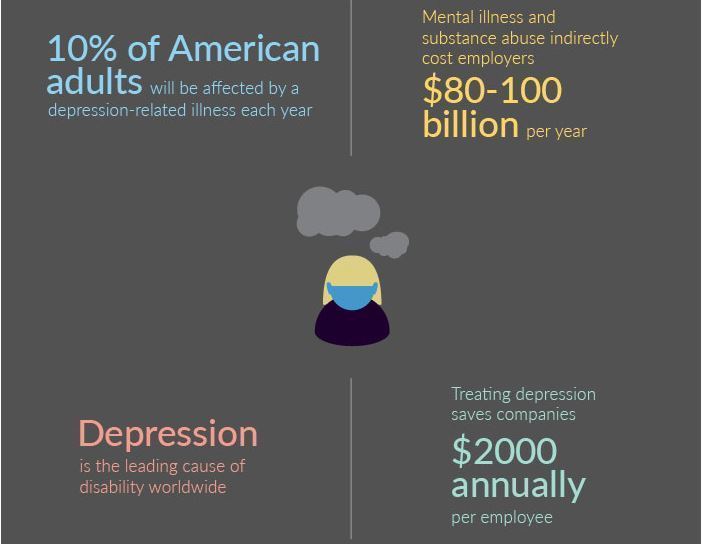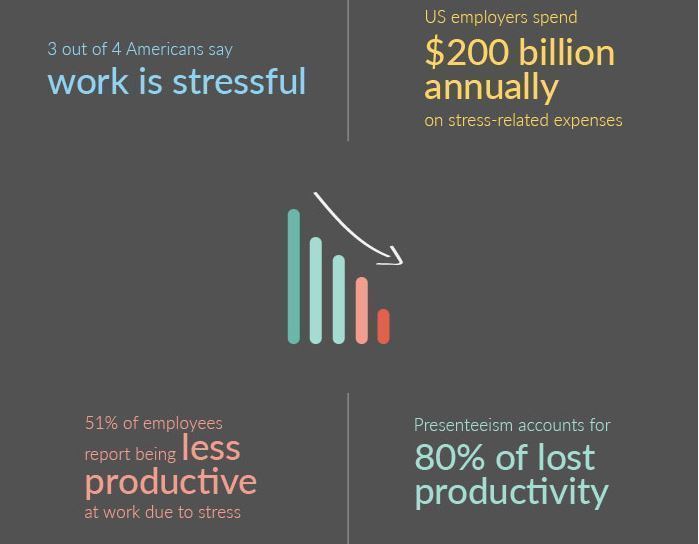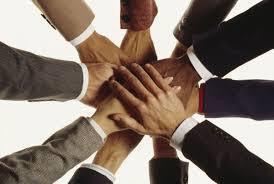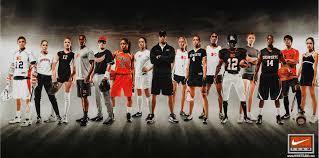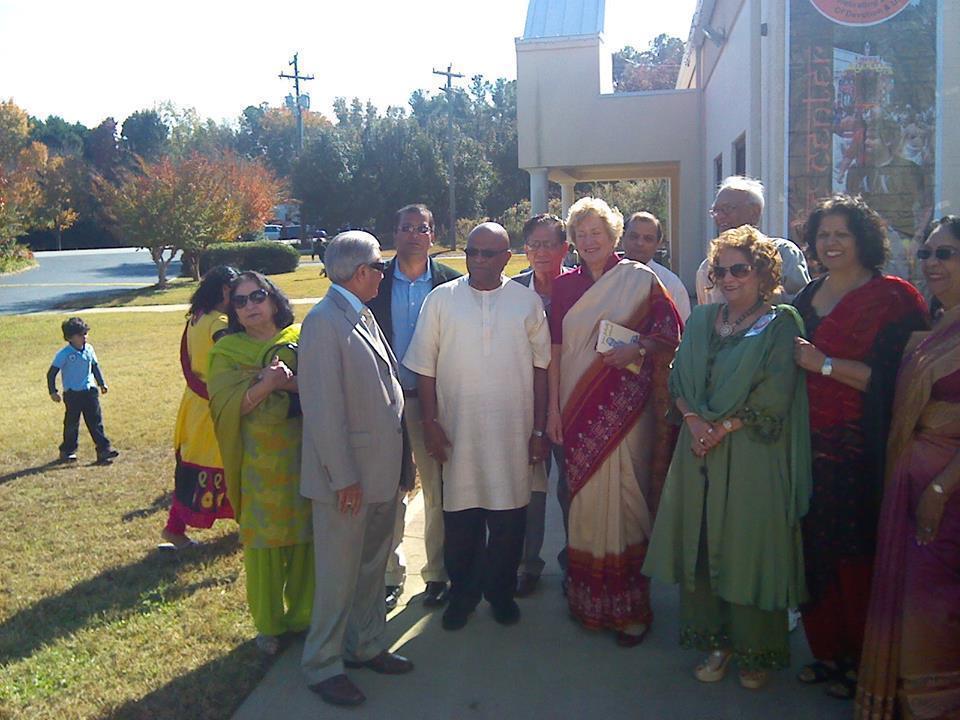Tag Archives for " dreams "
What’s The Difference Between Attending A Live Event & Watching A Video?
“You’re unique, different, and in leadership of your situation. Don’t compare yourself to anyone.” – Raj Gavurla
Have you attended an event in person and watched the same event on video? There’s a huge difference!
1. In person attendance, one actually senses, feels, and experiences the ambiance of the entire event. The featured speaker(s) message is more meaningful and engaging. You see things you don’t see watching a video. You participate in select activities and network (build relationships) with attendees (people you know and those you don’t know). Also, if you are fortunate you get to interact with the speaker(s) by asking questions or attending a private dinner the night before.
You might schedule other meetings during non-event time and see a new place or experience a magnificent place again. It also serves to get you out of the office and realize how everything is in some way interconnected. You broaden your business and life story.
2. When watching a video the value is greatly reduced. The meaning of what is being said can be distorted because the connection of being there in person isn’t there. If you think, how can that be? Then, video an interaction with you participating and then watch the video in private. You’ll see the differences and meaningfulness in value decrease.
There is a time for both. Determine which is of most value for your situation.
“Don’t let the noise of others’ opinions drown out your own inner voice.
Have the courage to follow your own heart and intuition. ” – Steve Jobs
For programs and services, contact Raj at 864.569.2315, raj@rajgavurla.com, LiiiVEN.
New Resource:
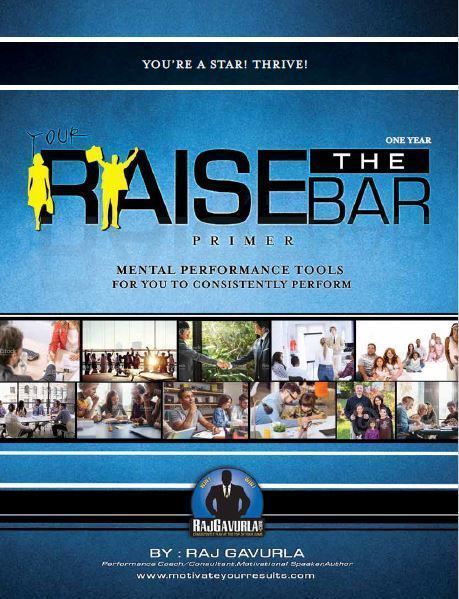
Consistently achieve your business goals, break-through performance barriers, and stay motivated and inspired with my mental performance coaching workbook.
Build and grow your mental performance skills using your own thoughts with a very simple mental structure. The workbook becomes customized by you with your own thoughts because your mental challenges are unique to your level of business and what’s happening in your life. You practice the knowledge skills of business. How about the mental performance skills to consistently learn how to perform in “the zone” (optimal performance) for success? Order Now! https://www.motivateyourresults.com
How To Win Playing Better Tennis?
“Win playing better tennis.” – Raj Gavurla
I really understood you had a tennis match after watching the NBA Playoffs last night. How did it go? My job is to performance consult and performance coach at the professional, college, academy, high school, and recreational levels. The main difference between them is better mental performance skills. Most of the pros know how to hit the ball. It’s bettering their mental performance skills to play better tennis they need to win more.
Yes, I also play tennis and I like playing with all levels because I approach each with a different frame of mind. All levels of players pose a different challenge to me. Recently, I’ve been playing with a group of recreational players. They see me warm up beforehand, bring my water, and my chair and watch me as I warm up and say “that’s what we need to do”. Yet, week after week they come out and just start playing. They warm up without practicing their volleys and overheads. It’s as if they are enthralled with the baseline although they are playing doubles. There is no serve and volley except me.
The wild thing is it is just as competitive as a Grand Slam Final with lesser mental performance skills and tennis skills. Since I can help their mental performance skills, I do and they’ve wised up and some take lessons on tennis technique (how to hit the ball better). They haven’t wised up yet to take mental performance coaching lessons.
While playing “my coach” (I call one of them that). He tells me to “play with better players” and is very hard to please. I can hit ten “nice” or “good” shots and he’ll point out the three I didn’t hit well. He compares me to professional players like Federer and Nadal. I’m honored by the comparison as he does know what he’s talking about when I’m not consistent or don’t move into the right position. He says, “I watch them on T.V. and at live tournaments”. Obviously, I’m not as robust of a tennis player as the pros.
Recently, we were closing out a match and he was telling me not to do this and that. I called a mental performance skills coaching timeout. I said, “all this negativity isn’t helping us”. How about saying, “finish the match” or “see the ball”. A week later we were in a similar situation, and he was encouraging and motivating and for a long period silent. After we won, he actually complimented me with “good”. Wow! Then he said “you need to win a Grand Slam”. I wish he was around sooner in my tennis life.
I gave him an autographed copy of my Your Raise The Bar Primer: Mental Performance Skills workbook. He looked at it and said “that takes commitment”. My response, you can stay at status quo and go through the motions week after week or have fun and win more. Which do you want? My coach has been working on it. I already see a difference in his ability on the court. If you need cabinets installed that’s my coach’s real job.
Yes, I do need to play with better players but I enjoy playing with all levels and at the recreational level I’m able to work on shots that I’m not able to do so against better-skilled players without first honing it. Some of the guys played in high school and one in college so it’s not as if they are beginners.
For those who still are working on technique, here are six videos to watch showing the legendary, Andre Agassi. I myself am hitting better volleys, overheads, and serves after watching. Remember, you also need to work on bettering your mental performance skills. The combination helps you win playing better tennis.
“Children are wonderfully confident in their own imaginations.
Most of us lose this confidence as we grow up.” – Sir Ken Robinson
For programs and services, contact Raj at 864.569.2315 or raj@rajgavurla.com, LiiiVEN.
Performance and Entrepreneurial Leadership In Management Needed for Mental Health In Your Workplace
“Win your better outcomes: High Value and Valued ROI” – Raj Gavurla
Your valued employee is missing work more often and you can tell some things aren’t making sense. As leadership and management, you think about what’s happening to them. Then, your office manager or human resource person informs you they gave them the Employee Assistant Program (EAP) phone number. Of course, something serious happened yet you’re still puzzled. However, because you don’t know what to do or policy you don’t initiate to share authentic dialogue with your valued subordinate.
Your subordinate doesn’t know what’s happening as all they think is I’ve been having very unusual thoughts and not feeling well. It’s as if the microprocessor (brain) in my computer (body) isn’t consistently functioning. They really don’t know when told they have a mental health diagnosis what that means. They just hope the doctor determines the right treatment to help/cure/exhibit teamwork to allow them to successfully continue working and living a robust life. Sometimes for a percentage of workers, this happens and they continue successfully working and living a robust life. Often times the facts are this doesn’t happen and your employee’s performance is valued for periods of time and then an episode or something happens and they miss work or they aren’t exhibiting their consistent valued performance. A mental health challenge doesn’t discriminate based on socioeconomic or sociodemographic status.
There is a highly customized fluid solution for your valued subordinate. An example is:
1. You (Boss) initiating and sharing private authentic dialogue with your employee. It takes research better outcomes, preparation, interaction, and communication to deliver better outcomes for your subordinate (employee).
2. Understanding what his or her treatment plan is and the teamwork needed.
3. Forming a “small individual/personal matters team/group” to help your subordinate by involving a select group of trained employees as this employee’s support system in your workplace.
4. Understanding the high-value importance/urgency of their family, work, and financial sustainability to your subordinate’s wellness is essential. Their family is experiencing similar uncertainty as you about the well-being of your employee.
5. By taking the initiative and being proactive with a process your employee becomes better and your costs tremendously decrease because your employee is still able to work although it might be scaled back and is given the review and evaluation of their work during this time to continue being a forward performing valued successful employee.
Yes, taking these steps are asking for more effort on your part as Boss and employer. However, the following are some of the better outcomes (results) from taking initiative:
1. I know as employer, Boss, team, and employee each is doing everything they can to see each other succeed and your clients succeed. As an employer, you don’t have to do the bare minimum to be in compliance. There are value-add resources that can help you. As a strong mental health advocate, performance consultant/coach, and entrepreneurial leadership expert, my services might be a value-add to your current protocol for this situation.
2. Donating to charity is important and I encourage you to continue doing so to make your business and community stronger. However, a lot of times companies donate to non-profits (a humanitarian cause/need) without knowing the person they are helping to receive support services. By allocating funds for mental health in your company, you are essentially creating “charity in the workplace” and seeing your dollars actually being put to use for your valued employee and receive quality work completed for your efforts.
3. The sensation of having this humanitarian lens is very fulfilling, highly satisfying, and delivers a win for all (your business and community). Businesses are here to contribute to family and societal progress. Being a humanitarian to me means more than “spiritual brothers and sisters have to eat”. Being a humanitarian means “spiritual brothers and sisters have to thrive”. We are very capable of this mission and aspiration being a reality because of the forward progress we consistently make in employer/employee relationships and societal progress.
4. Most likely your employee becomes more loyal and continues to make forward progress in your company. Also, you now have an employee with high-value empathy skills and is part of your succession planning for your “small personal matters team(s)/group(s). Although most of your employees don’t have a mental health diagnosis, they do have mental health challenges whether spurred from a workplace issue or life issue that sharing authentic dialogue with select people in a “small personal matters team/group” would greatly benefit your business.
5. Mental health is our current major employer/social health challenge to the robust viability of our workplace we have to triumph along with cancer (you could imagine this affects a person’s mental health).
6. I’ve heard too many personal stories of talented, skilled, and educated people who are underemployed and not doing meaningful work. Because of this, there might be relationship problems because of the stigma associated with mental health and the individual might lose hope.
Sports often is at the forefront of employer and societal progress. An example is Lebron James addressing the Cavaliers in the locker room, welcoming, and helping Larry Sanders (mental health challenge) join the team and continue to progress in his NBA career. Yes, there are a lot of small business owners who are also helping and supporting individuals with a mental health challenge. How about your Fortune 500, mid-size, or over 50 employees small business?
Remember, being a humanitarian is more than “spiritual brothers and sisters have to eat”. Being a humanitarian is “spiritual brothers and sisters have to thrive”. It’s a win for all. It’s worth it!
If you are an executive, in management, or are a workplace leader, who is challenged by mental health in your business, please contact me to share authentic dialogue. Your leadership is needed and wanted.
“One’s destination is never a place but rather a new way of looking at things.” Henry Miller
For programs and services, contact Raj at 864.569.2315, raj@rajgavurla.com, LiiiVEN.
You Don’t Need To Live A Double Life In Your Workplace
“You Don’t Need To Live A Double Life In Your Workplace.” – Raj Gavurla
Do you come to your job or the playing field leading a double life? You don’t need to. How is this possible? I’m there to work (complete tasks, etc.). That’s what they pay me to do. Years ago there was a job I inquired about with someone who worked for the company. He proceeded to tell me “you have to set up equipment”. I waited to see if he had more to say. He didn’t. I wasn’t interested in the job. Why? Because work is more to me than completing tasks (it’s part of the job) and receiving benefits. I understand you have family and friends outside of work you have fun, rewarding, and enjoyable camaraderie with. How about having fun, rewarding, and enjoyable camaraderie with your colleagues or teammates?
Camaraderie is one of the keys that keeps employees performing, retains, and recruits. It also plays a major role in wellness (well-being), motivation, inspiration, engagement, a positive attitude, leadership, and execution.
What’s a solution to nurture camaraderie in the workplace? By using a small group personal team matters approach. Do you have thousands, hundreds, less than fifty, ten to twenty, five or fewer employees or teammates? The larger the business, organization, or team the harder it is to have camaraderie with everyone. Regardless of size test the following:
Break up into “small personal teams”. A “small personal team” is a group that discusses (has dialogue) about personal matters not directly related to your job. For example, your family, what you’re doing this weekend, what you did this past weekend, your health, nutrition, fitness, your parents, kids aspirations, your non-work challenges, crisis, someone passing, accident, hobbies, movie, best place to get something, book you’re reading, mountains, sports, festivals, etc. Apply the learning.
A Customized Structure Might Look Like:
1. Ask people to participate sharing why. Do not require them to participate.
2. For those who join a personal matters team, make what’s discussed confidential. That doesn’t mean you can’t share your situation with someone outside of your group. Use your discretion.
3. Meet once a week for 45 minutes to an hour in a quiet place (conference room, courtyard, etc.)
4. Talk about and share personal matters important to each group member
5. Close the meeting
Use Metrics and Collect Data On The Outcomes:
Are employees mentally performing better?
Is employee retention increasing?
Is it easier to recruit?
What effect does it have on wellness (well-being), motivation, and inspiration?
What effect does it have on engagement, a positive attitude, leadership, and execution?
Small Personal Matters Team Examples:
Look at an amazing family
Look at a business team. One of the things employees, athletes, investors, donors, and philanthropists look at is the teamwork exhibited.
Look at our military. They have tremendous camaraderie protecting each other, to survive, and protect us. They know each other and have nicknames for each other making it easier to accomplish their mission.
Look at a sports team and you hear athletes talk about the camaraderie or if retired the camaraderie is what they miss.
I remember from reading Oscar Robertson’s biography he worked with people of a different skin color and they never had time for camaraderie. Just do the work because in those times that’s how it was. People didn’t know each other at work and never met outside of work with people of a different skin color. He said, “that hurt”. I’m sure some people of the other skin color had the same thought and feeling, “that hurt”. Thankfully, we the people have made tremendous cultural and societal progress.
Another example, I went to college to graduate/get an undergraduate degree in electrical engineering. That was the main goal. It’s the camaraderie with a few friends I remember and miss most. Although we don’t talk often or see each other as often I know, feel, sense, and believe we are connected forever.
My final example are my friends from Leadership Greenville. I shared with a small personal matters group my mom had a stroke. One told me his dad passed away from a stroke and another told me they had a family member who had a stroke and it’s a slow process. People get better. Until the emergency personnel told me your mom had a stroke, I’ve heard of the word stroke but knew nothing about it. Learning about a stroke and talking with my small personal matters team gave me lived experience insights I couldn’t get from a textbook that helped me to mentally perform to be a caregiver for my mom to make her well. She is talking better and she needs and wants to walk better and drive a car.
Implementing small personal matters teams in your businesses, organizations, and teams might transform the narratives, conversations, and outcomes. It should be helpful too and take pressure off and inhibit the performance anxiety your employees, team leaders, supervisors, managers, bosses, management, executives, and owners are experiencing. Yes, conventions, conferences, and special events are still needed and wanted for all your employees or sports team to participate in.
“A goal is not always meant to be reached, it often serves simply as something to aim at.”
– Bruce Lee
For programs and services, contact Raj at 864.569.2315, raj@rajgavurla.com
Win: A Sense of Respect Should Be Automatic, Not Earned
“A sense of respect should be automatic, not earned.” – Raj Gavurla
“If you set your goals ridiculously high and it’s a failure, you will fail above everyone else’s success.” – James Cameron
For programs and services, contact Raj at 864.569.2315, raj@rajgavurla.com
Preview Video: Transform Your Performance & Leadership
“Transform your performance and entrepreneurial leadership in business, work, sports, and life.”
– Raj Gavurla
“The way you tell your story to yourself matters.” Amy Cuddy
For programs and services, contact Raj at 864.569.2315, raj@rajgavurla.com
CHANGE ISN’T A COMPETITIVE ADVANTAGE: WHAT IS?
“Fortunately world-class business occurs with preparation and communication.” – Raj Gavurla
Since change isn’t a competitive advantage, how are businesses, organizations, and teams solving their need(s) for performing (high value/value add) better results (better ROI/higher margins) in a faster time?
Answer: Transform Performance
Examples:
1. Most organization development shows a top-down flow. Whether their competitive advantage starts at the top (trickle down) to the bottom or from the bottom (grassroots) to the top. How about transforming your performance lens to organization development showing forward performance (—–> timeline fashion): Founder-Board-President/CEO – Each Colleague (Teammate) – Business Unit – Division – Department – etc. as they came into existence in a win forward performance for your competitive advantage? Forward performance mentality is essential to living (doing) for each person to thrive.
2. Sometimes when I shoot baskets kids are also shooting on the same basket. When they make a shot and I grab the rebound they are quick to say “change” meaning they want me to pass them the ball as a return for making their shot. Since I’m also a performance consultant and private performance mental skills coach, I want to tell them “Change isn’t a competitive advantage. I would have thrown the ball to you without you saying change.” Instead, they need to shoot the ball from the same spot the same way (“repetitions – keep going to the well”). If an adult paid my fee, the kids win forward performance.
3. The better tennis player you are the more mental tennis is. What differentiates the number one players and teams in men’s and women’s tennis is their mentality. What are you doing to work on your private performance mental skills so you consistently become a better tennis player.
4. In business, work, sports, and life identify your need(s) to win forward performance whether experiencing success (fun) or negativity. Most likely you know what to live (do) and/or you might need to pay for support service(s) to work with you to solve your need(s) to win forward performance.
5. How do you accomplish any endeavor in life (i.e. your dreams, vision, goals, and/or mission)? By living (doing) it.
“You cannot start the next chapter of your life if you keep re-reading the last one.”
– Michael McMillan
For programs and services, contact Raj at 864.569.2315, raj@rajgavurla.com
Situational Mindset: Difference Between Better Outcomes, Performance, Production, Successes, Fun, Enjoyment, Celebration
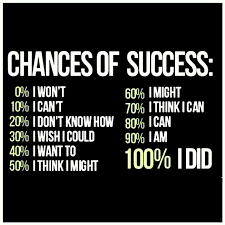 A situational mindset is a skill you use to fully engage yourself in a process and culture. Whether one person, two, a group, or many stakeholders, there are diverse people with personalities, perspectives, agendas, pressures, and what’s important to them. Examples are: Your mom needs emergency surgery. Your situational mindset is serious and prayerful, the doctor reports she was able to remove all of the clot (your situational mindset is thankful), you visit your mom (your situational mindset is loving, positive and encouraging), your mom comes home (your situational mindset is helping her get better), during this time of recovery (your situational mindset varies from loving, serious, fun, funny, success, enjoyment, relief, prayerful, progress, frustration, stress, hope, caring, and sharing).
A situational mindset is a skill you use to fully engage yourself in a process and culture. Whether one person, two, a group, or many stakeholders, there are diverse people with personalities, perspectives, agendas, pressures, and what’s important to them. Examples are: Your mom needs emergency surgery. Your situational mindset is serious and prayerful, the doctor reports she was able to remove all of the clot (your situational mindset is thankful), you visit your mom (your situational mindset is loving, positive and encouraging), your mom comes home (your situational mindset is helping her get better), during this time of recovery (your situational mindset varies from loving, serious, fun, funny, success, enjoyment, relief, prayerful, progress, frustration, stress, hope, caring, and sharing).
In your business, organization, and team you also encounter the above situational mindsets in a different context.
For clarity and preparedness let’s look at a process and culture for you to succeed:
Better Outcomes
Yes, you need to know what is your dream, vision, goal(s), mission, motivation, inspire yourself, and incentive(s).
So the dream is about how the fulfillment of better outcomes will enable you to dream more? Vision is the leadership and buy-in to get there, goal(s) are the milestones in your journey, and your mission is waking up daily to motivate and inspire your successes. Motivation is your fuel. Inspire yourself to consistently do better. Incentive(s) is everything expected and unexpected that goes along with pursuing your situational better outcomes mindset. What are your better outcomes? Capitalize on the learning. It takes sharing inspiring authentic dialog.
How To Consistently Perform Better?
This essentially is “how do I consistently perform better?” You need to remove some things or habits and continue building and growing your mental performance skills. When on a team, ask “how do we consistently perform better”?
In an organization, ask “how does the organization consistently perform better?” For me, after completing the better outcomes section I constantly am looking for ways to consistently perform better. In this changing, diverse, and financially outdated system the forces of democracy, innovation and entrepreneurial vigor, and a spirited beacon of hope consistently creates a better life, better living, and better future. It’s a new way of thinking for some people. In a situational performance mindset more organizations, teams, and individuals need to spend more time in the situational performance mindset. The reason is illustrated in the next section. Yes, you want to earn more wins and more income. Now that’s established learn how to learn to consistently perform better and the more wins and more income come to you. You don’t need to chase it.
Do Your Best Production
Before management, people were working on their own to feed and clothe them self and their family. As the concept of management came into existence from Frederick Taylor to Peter Drucker management has learned their people, partnerships, and relationships are what makes the difference in their successes. The creative, innovative, and invention of technology, machines, and robots are handling things you no longer need to do. For example, agriculture has advanced, manufacturing plants are cleaner and less manual labor is being done, and mobility is delivering solutions when needed without delay.
More and more we are advancing from a situational production mindset to a situational performance mindset. Companies are realizing to succeed management doesn’t need to do all the situational performance mindset work while non-management does the situational production mindset work. It puts too much pressure on management’s situational performance mindset. Instead of fully engaging employees in the process and culture, it puts too much uncertainty on employees’ situational production mindset.
Successes, Fun, Enjoyment, and Celebration
The solution(s) which is implemented to varying degrees based on an inordinate number of criteria, wants, and needs are to fully engage your organization and personnel in better outcomes and situational performance mindset and spend less time in the situational production mindset. Then how does anything get done? “We are about doing you say.” Here’s how: You work on creating, innovating, inventing, and invest in the right service(s), product(s), technology, machines, and robots to develop and grow your business and clientele.
You invest in support services such as professional speaker(s), coach(es), consultant(s), and trainer(s) service(s) and product(s), who have a solution and then fully engage them to help you consistently perform better. In my speaking, coaching, and consulting, my clients need help in one or more of the four situational mindsets. Over the years having seen this need in companies of all sizes, different types of teams, and industries, I created, innovated, and invented to put together an intervention package. It consists of the Your Raise The Bar Primer: Mental Performance Tools workbook for your situational performance mindset, highly customized individual or team coaching, a customized team workshop, and performance consulting. From using my workbook you’ll realize not only how to accomplish your list, you’ll also realize how to put a lens on it for better outcomes. Currently, businesses and athletes are using it to make good progress. You don’t need to struggle, live in apathy, or suffer.
There are more successes, fun, enjoyment, and celebrations for you to partake in. When’s the next banquet, corporate party, convention, cookout, conference, cruise, or parade? It’s an endless fully engaging process and culture. I’m looking forward to seeing you more successful (practical forward mobility) as that’s my job and in my mission statement.
“Success isn’t about being the best. It’s about always getting better.” Behance 99U
For programs and services, contact Raj at 864.569.2315, raj@rajgavurla.com.
FORWARD PERFORMANCE IS COUNTERINTUITIVE
“Breaking through a performance barrier is counterintuitive.” – Raj Gavurla
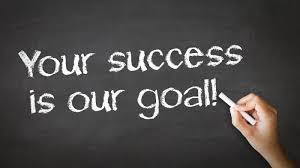
Look outside! Did you plant those trees, create the sky, the clouds, warmth of the sun, birds, grass, air, and those mountains? Your answer is “no”. My special news for you is “there are no days off from living”. Believe me, you know why.
In my performance, entrepreneurial leadership, and sports/athletic coaching/consulting, I use to hear from my clients, “I had a bad day”. “I was off today.” No way! When clients receive coaching and complete their Your Raise The Bar Primer: Mental Performance Tools workbook they soon realize what I mean. Daily, I have them rate their day.
An example of their choices and the criteria we agree upon in our session might look like the following:
Auspicious Day
Today is my birthday! Any grand occasion is permissive. Think birthdays of family, anniversaries, graduations, a spiritual occurrence, special recognition (awards), end of a project, a big win, your firsts, and holidays. Do my exercises and stretches.
Robust Day
The list is private to me, however, some items are when I have “unexpected success”. It’s the easiest type of success. When I learn and apply what I learned for better performance. I take what I’ve been working on to the next level. I meditate, do my exercises, and stretches.
Perfect Day
The list is private to me, however, when I do my exercises and stretches, eat right, work, and have something restful, relaxing, fun and enjoyable in the evening. Came up with a “creative innovative inventive entrepreneurial idea”. I meditate.
Very Good Day
The list is private to me, however, when I accomplish a perfect day without coming up with a “creative innovative idea”. I work, eat right, do my exercises, and stretches.
Good Day
The list is private to me, however, when something takes longer than expected or usual and I finally figure it out. I do my exercises and stretches.
Not So Good Day
The list is private to me, however, anything bad that happens to me or someone I know. Also, my computer crashes etc. I didn’t do my exercises and stretches.
My Star
Then I complete “my star” in my workbook by filling in a “new record”, building a relationship forever, and/or “I met someone new” and had a real conversation with them. Success!
I also pray throughout the day when I need or want to. Now, you won’t ever have a “day off from living” or a “bad day”. After sessions with my client, they begin to see how to really use my workbook. They become forward performing instead of “negative” towards them self or others. I’ll repost this on Monday, however, I wanted to give you a high-value target on my birthday, an auspicious day. Apply the practical learning.
Value and Benefits of Non-Violence
“Live your great dreams they become greater.” – Raj Gavurla
When I heard the name Mahatma Gandhi, I did not realize his importance globally. Non-violence resonated with me. Think of the opposite. What’s the need?
Before attending a talk on non-violence, I thought of the violence I have seen. My first discussion of violence was in fourth grade. My friends and I were discussing how to defend ourselves. My Bruce Lee impersonation with sound effects sent a friend frighteningly into the supplies closet. Two guys fighting in the school cafeteria in sixth grade was my first encounter with violence. One threw chairs and the place cleared out with students in shock and not knowing how to respond. We couldn’t believe what was happening.
The next occurrence of violence occurred on a Sunday driving through downtown as a sixteen year old. As I slowly drove by, two men were fighting. A car stopped ahead of me and a mountain of a man stepped out in a three piece suit. He single handedly separated the two. They didn’t have a chance!
In history class my high school teacher assigned us a term paper. My paper was on the book, The Life of Mahatma Gandhi. A fascinating read by Louis Fischer and years later in 1982 the movie Gandhi played in theaters. The most vivid scenes for me was a reporter on the phone relaying the story of how Gandhi was leading a non-violence movement in South Africa and then India.
Violence didn’t occur again until I visited Hollywood on a tour bus parked adjacent to Grauman’s Chinese Theatre for tourists to shop for souvenirs. People screamed and began to gather, therefore, I rushed across the street because I’ve heard of people passing out from seeing a star. Brad Pitt, then they faint.
A car pulled up and three guys attacked another. A mob ensued. They were beating him and he fell to the ground. They continued to kick him! The girls with the guys tried to stop the violence. As the girls were being pushed aside, losing footing, and clothing, me and a guy running from the other side of the street were about to step in to help the girls. I’m not sure what I would have done. In hindsight, I think the best I could have done was to yell at the top of my voice. Fortunately, we heard a police siren and the guys doing the beating ran off.
As a motivational and inspirational speaker and author, I’ve been on the platform in front of diverse groups: Business and community groups, athletes, detainees in the mental health quad at the Greenville Detention Center, facilitate a mental health support group, and train police officers. Many of them have experienced violence either perpetrated by another or themselves.
I emphasize the following:
1. Non-violence towards yourself
2. Non-violence towards another
To have a deeper appreciation of non-violence the thought provoking talk I attended was part of an event at the Vedic Center of Greenville in Ahimsa Hall by Shrimiti Kamalaji (Gandhi Foundation). Ahimsa means non-violence.
My question to her: With the increase in non-military violence how do we create a non-violence movement in our community and society in order to consistently enable individuals’ dreams, aspirations, and hope successfully?
1. Non-violence isn’t to be legislated
2. Use self-discipline, aspirations, and passion for inner-peace
As I reflected on her answer, I think of the courage of Malala Yousafzai, (https://www.youtube.com/watch?v=3rNhZu3ttIU, https://www.youtube.com/watch?v=MOqIotJrFVM, https://www.youtube.com/watch?v=vrWttENgWNE) and of using books, pens, teachers, and education as a weapon and the non-violence movement in Hong Kong for democracy.
The words of Gandhi still reverberate:
“It has always been a mystery to me how men can feel themselves honoured by the humiliation of their fellow beings.” – Mahatma Gandhi
Think about what non-violence would look like in your community.
1. The evening news wouldn’t open with someone being shot, a school shooting, or a story on bullying.
Deeper
2. Doctor’s offices and hospitals serve sick people not cases of domestic violence
Deeper
3. There’s no suicide.
Deeper
What fills the void?
Consistently enable individuals’ dreams successfully. Without enabling great dreams there is apathy and violence as means for survival. Be determined to help, assist, and support someone you know and don’t know with earning and achieving great dreams because by doing so we find better ways and create new jobs (an occupation that didn’t exist) and better jobs (ones with career progression) to generate economic growth, peace, and raise the standard of living locally, nationally, and throughout the world.
Before we are capable of doing so, we need non-violence to produce economic growth and peace. What can you be involved with or do to create a non-violence movement in your community?
List three ways non-violence brings economic growth:
- ____________________________________________________________________
- ____________________________________________________________________
- ____________________________________________________________________
List three ways for you to benefit from non-violence:
- ____________________________________________________________________
- ____________________________________________________________________
- ____________________________________________________________________
By having a conversation with a group or a person about the items you listed you have an opportunity to enrich and expand or create a non-violence movement in your community. We will have a better future by creating a non-violence movement in communities throughout the nation and world. Enable great dreams – they become greater.


